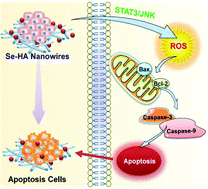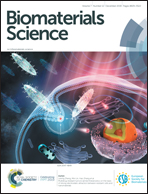Selenium-doped hydroxyapatite biopapers with an anti-bone tumor effect by inducing apoptosis†
Abstract
One-dimensional hydroxyapatite (HA) particularly mimics the structure of mineralized collagen fibrils and displays superior mechanical properties such as toughness. Herein, we report Se-doped HA/chitosan (Se-HA/CS) biopapers constructed with self-assembled Se-doped HA nanowires and chitosan. The Se-HA/CS biopapers with high flexibility and manufacturability can not only be further processed into arbitrary shapes by folding or using scissors but also display high performances in in vitro/vivo anti-bone tumor studies. The Se-HA/CS biopapers are more inclined to inhibit the growth of tumor cells (HCS 2/8 and SJSA cells) than that of normal human bone marrow stromal cells (hBMSCs). The potential mechanisms of this meaningful anti-tumor effect were investigated, such as reactive oxygen species accumulation and the activation of apoptosis and the underlying signal pathway involved (including caspase family, Bcl-2 family and JNK/STAT3). The results demonstrate that Se-HA/CS biopapers may inhibit the growth of HCS 2/8 and SJSA cells by synchronously inducing JNK activation and STAT3 inhibition and consequently promote the apoptosis of these cells. Furthermore, the in vivo anti-tumor studies confirm that the Se-HA/CS biopapers obviously suppress the growth of patient-derived xenograft tumor models.



 Please wait while we load your content...
Please wait while we load your content...